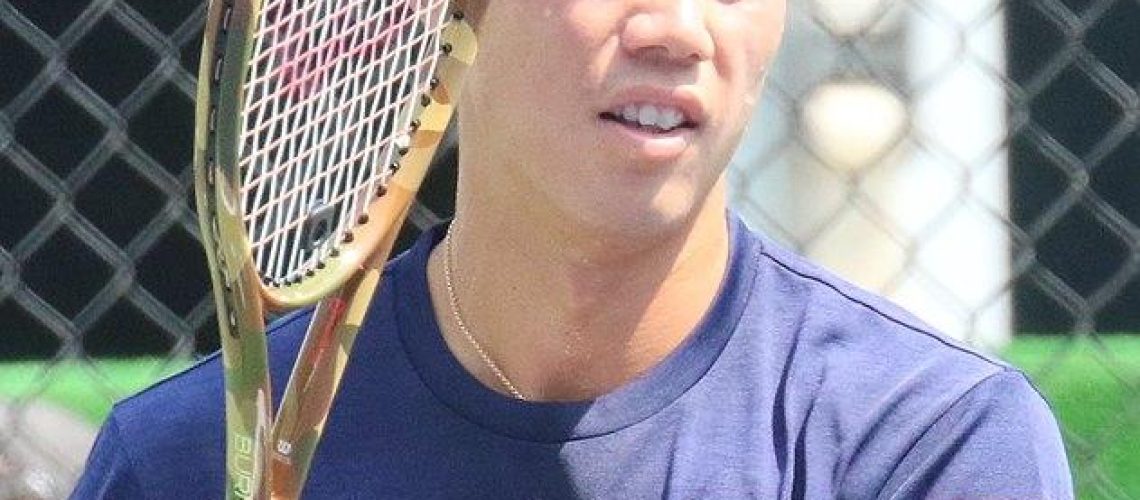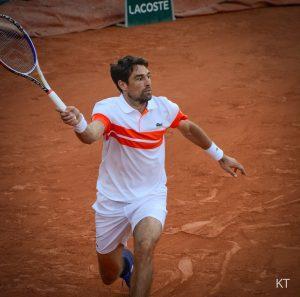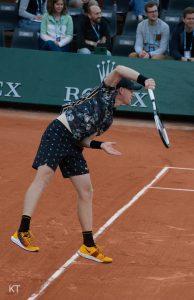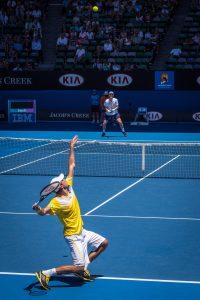We may earn money or products from the companies mentioned in this post.
Introduction

In the fast-paced and competitive world of tennis, every player aims to secure victory on the court However, in certain situations, players are granted an advantageous position without having to compete in a match This is known as a “bye”. In this article, we will explore the definition of a bye in tennis, its purpose, and the factors that influence its allocation
Definition of “bye” in tennis
When it comes to tennis tournaments or competitions with an odd number of participants, there may be instances where one or more players receive a bye Essentially, a bye is when a player is exempted from playing in the first round or rounds of a tournament and automatically advances to the next round without having to compete against any opponent
This unique term originates from the game of cricket and has made its way into various sports including tennis It often creates excitement and anticipation among both players and spectators as they wonder who will benefit from this advantageous position
Purpose of a bye
The main purpose behind granting byes in tennis tournaments is to ensure that the competition progresses smoothly while maintaining fairness for all participants By giving certain players automatic advancement to subsequent rounds, organizers can balance out brackets and avoid potential scheduling conflicts caused by having an odd number of players
Byes also serve as rewards for higher-ranked or seeded players who have earned their positions through exceptional performance or previous success It allows them some rest time before facing tougher opponents further into the tournament
Factors influencing the allocation of byes
The allocation of byes is not arbitrary but rather depends on various factors determined by tournament organizers:
-
Tournament format:
Different tournament formats require different approaches when it comes to allocating byes For example, in a single-elimination tournament, the number of byes needed will depend on the number of participants and desired bracket structure -
Player rankings:
Seeded players usually receive preferential treatment when it comes to byes Higher-ranked players are more likely to receive a bye as a reward for their standing and skill level -
Tournament rules:
Each tournament has its own set of rules regarding the allocation of byes Some tournaments may prioritize local players or previous champions while others may have specific criteria based on nationality or age categories
Overall, the allocation of byes in tennis is a strategic process aimed at ensuring fairness, maintaining player energy levels, and facilitating smooth tournament progression By better understanding what a bye entails and how it is determined, both players and fans can appreciate this unique aspect of tennis competitions
When it comes to tennis tournaments, there are various types and structures that players and fans alike should be familiar with Let’s dive into the different types of tournaments and their bye structures
First up, we have the prestigious Grand Slam tournaments These are the four major events in tennis and are considered the most important and coveted titles in the sport The Australian Open, French Open, Wimbledon, and Open make up this elite group of tournaments Each Grand Slam has its own unique characteristics and traditions that add to their allure
Moving on to the ATP (Association of Tennis Professionals) and WTA (Women’s Tennis Association) tour events, these tournaments offer players a chance to compete against some of the best in the world throughout the year Within this category, we have different series and levels of competition
The Masters 1000 Series for ATP and Premier Mandatory & Premier Five for WTA represent the top-tier events after Grand Slams These tournaments bring together the crème de la crème of men’s and women’s tennis, offering significant prize money and ranking points Players must navigate through multiple rounds against tough opponents to claim victory
Next up are the ATP/WTA 500 Series for men’s tennis and WTA International tournaments for women’s tennis These events provide players with an opportunity to earn valuable ranking points while competing against quality opponents Although not as prestigious as Grand Slams or Masters 1000/Premier Mandatory & Premier Five events, they still offer exciting matches and fierce competition
In terms of bye structures within these tournaments, it varies depending on factors such as player rankings, tournament size, format, and scheduling constraints Byes are typically given to higher-ranked players in order to reduce their workload during early rounds This allows them extra time for rest before facing stronger opponents later on
To summarize, there is a wide range of tennis tournaments available for both male and female players at various levels of competition From the illustrious Grand Slam events to the ATP and WTA tour events, each tournament offers its own unique experience for players and fans Understanding the bye structures within these tournaments is crucial in comprehending how players progress through the draw So, whether you’re a die-hard tennis enthusiast or new to the sport, there’s always something exciting happening on the tennis court
Advantages and Disadvantages of Byes in Tennis

Advantages for players receiving a bye
When it comes to tennis tournaments, receiving a bye can provide several advantages for players Firstly, they get the luxury of extra rest time between matches This can be crucial in maintaining physical and mental freshness, especially in longer tournaments where players may have to compete on consecutive days The extra rest allows them to recover from any niggling injuries or fatigue, giving them a competitive edge
A second advantage is the ability to avoid early round upsets In the earlier stages of a tournament, lower-ranked players can sometimes cause unexpected surprises by defeating higher-ranked opponents By receiving a bye and skipping these rounds altogether, top-seeded players can minimize their chances of falling victim to such upsets This ensures they progress further into the competition with less risk
The third advantage is improved chances of advancing to later stages By earning an automatic spot in the second round (or beyond) without having to win an initial match, players effectively shorten their journey towards potential glory This not only saves energy but also provides psychological comfort as they face fewer hurdles on their path to success
Disadvantages for players receiving a bye
While byes come with significant advantages, there are also some disadvantages that players need to consider One potential downside is the lack of match practice heading into later rounds Without having played an opening match, players may find themselves entering subsequent rounds relatively untested This lack of competitive action could affect their rhythm and timing against opponents who have already had valuable court time under their belt
In addition to limited match practice, another disadvantage is the increased pressure to perform well when finally stepping onto the court after receiving a bye Being automatically advanced to a later stage raises expectations, both from oneself and others This added pressure can sometimes lead to nervousness or performance anxiety, as players strive to live up to their higher ranking and justify their spot in the tournament Managing these mental pressures becomes crucial for success
Overall, byes in tennis offer advantages such as extra rest time, avoidance of early round upsets, and improved chances of advancing However, they also come with potential drawbacks like limited match practice and increased pressure Understanding and adapting to these factors is essential for players aiming to make the most of receiving a bye in a tennis tournament
Bye Allocation Process and Controversies Surrounding Byes in Tennis

Criteria for Allocating Byes in Various Tournaments
In the world of tennis tournaments, byes are a topic that often sparks debates and discussions The allocation of byes is based on certain criteria, ensuring fairness and maintaining the integrity of the competition
The first criterion considered is the player ranking system Rankings play a crucial role in determining who receives a bye in a tournament Higher-ranked players are more likely to be allocated byes as their performance reflects their skill and consistency on the court
Another factor that influences bye allocation is the seeding process Seeding involves assigning ranks to players before the tournament begins, with higher seeds receiving preferential treatment such as byes This process aims to create a balanced draw and give top-ranked players an advantage while maintaining competitiveness throughout the event
Controversies Surrounding Byes in Tennis
While bye allocation may seem straightforward, it is not without its controversies These controversies arise due to perceived unfair advantages for higher-ranked players and questions surrounding the role of tournament organizers and sponsors
One major controversy revolves around the perceived unfair advantage granted to higher-ranked players through byes Critics argue that this system inhibits lower-ranked players from having an equal opportunity to showcase their skills early on in the tournament It can also disrupt momentum for those who do not receive byes, potentially affecting their chances of progressing further
The role of tournament organizers and sponsors also comes under scrutiny when it comes to bye allocation Some critics claim that these stakeholders may influence decisions regarding which players receive byes, potentially favoring popular or marketable athletes over others who may be equally deserving based on rankings or performance
In conclusion, bye allocation plays a significant role in tennis tournaments, with criteria such as player rankings and seeding processes determining who receives this advantage However, controversies persist regarding the perceived unfairness for lower-ranked players and potential influence of tournament organizers and sponsors These debates continue to shape discussions around bye allocation in the world of professional tennis
Useful Links

The Wonders of the ‘bye’ on players at tournaments
tennis – Ranking points for a player who received bye
In what situation would a player get a bye? : r/tennis
Bye | Overview | ATP Tour | Tennis
Adult Tournament Info
bye 19 bye 19 – Player Profile – Tennis
B. Bye Tennis Tournaments, Results and Schedules 2023
bye bye to the bye
t Tennis Bye Funny Vintage Retro Tennis Player Tank Top
Women’s Tennis Earns First-Round Bye at NAIA National …
bye in tennis tournaments
How Do Tennis Draws Work? (The Ultimate Guide)
Cats Get First-Round Bye at WAC Men’s Tourney
Draws and Points
John Ivar Bye Tennis Player Profile
How Byes Work in a Tournament
Tennis Tshirt Sorry Can’t Tennis Bye Funny Tennis
Horned Frogs Stave Off Texas Tech, Clinch First Round …






